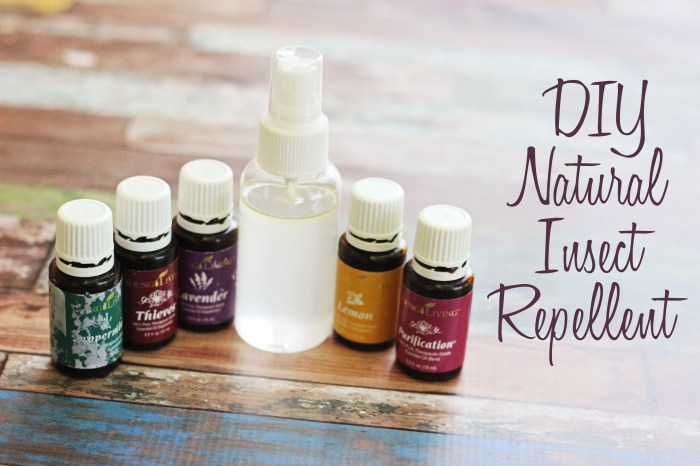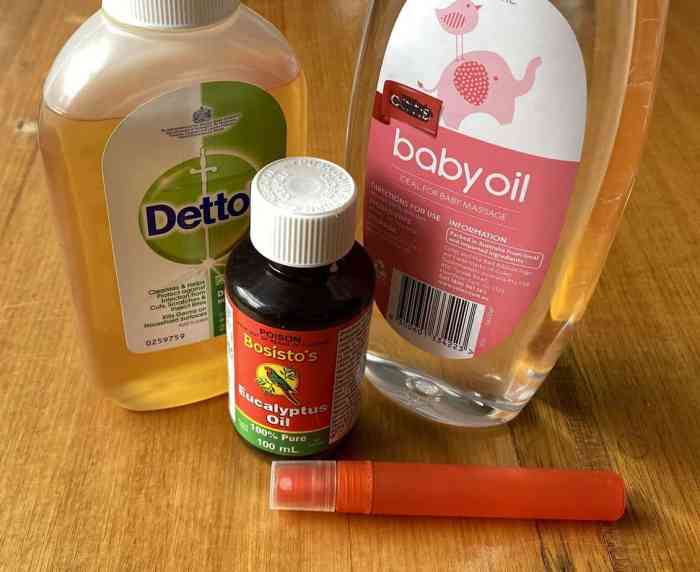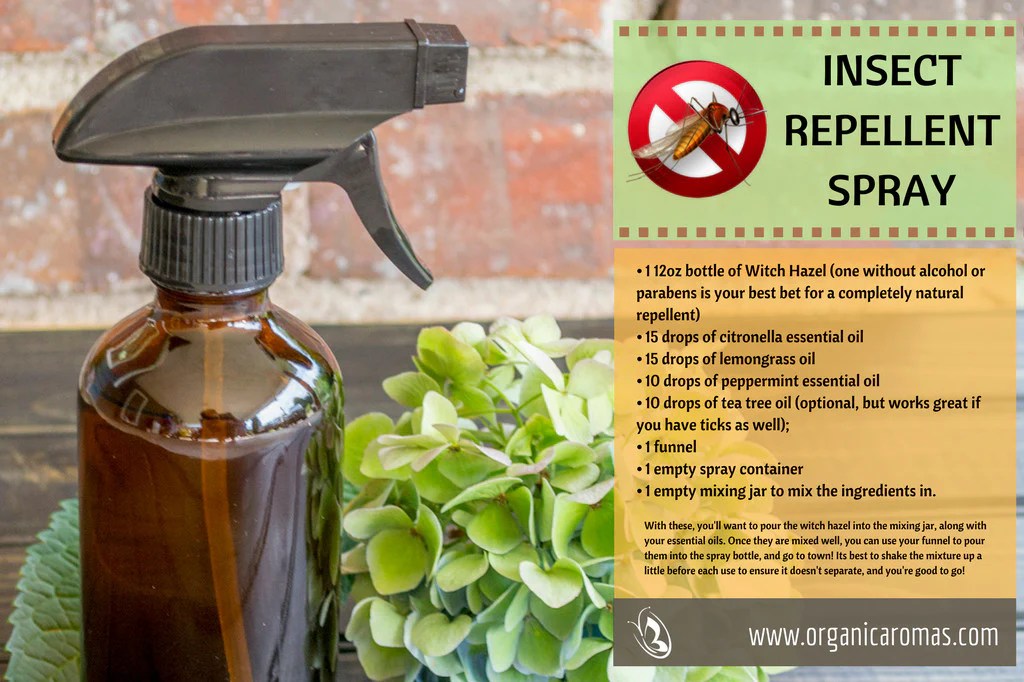DIY natural insect repellent takes center stage, offering a safe and effective alternative to chemical-laden sprays. This guide explores the world of essential oils, herbs, and other natural ingredients that can effectively deter pesky insects without harming the environment or your health.
From repelling mosquitoes and ticks to keeping flies at bay, this comprehensive resource provides a wealth of information on creating your own custom blends. We’ll delve into the science behind natural insect repellents, discuss the effectiveness of different ingredients, and offer practical tips for application and storage. Whether you’re seeking relief from itchy bites or simply want to reduce your reliance on harsh chemicals, this guide empowers you to create a natural and effective insect repellent that works for you.
Introduction to DIY Natural Insect Repellents
In the realm of insect control, the pursuit of effective and safe solutions is paramount. While chemical repellents have long been a popular choice, growing concerns about their potential health and environmental impacts have prompted many to seek natural alternatives. DIY natural insect repellents offer a safe and effective way to deter unwanted insects, harnessing the power of nature’s own defense mechanisms.
DIY natural insect repellent is a great way to keep bugs at bay without using harsh chemicals. While you’re working on your DIY projects, you might also consider taking on a mini split installation DIY project. It’s a more involved project, but can save you a lot of money in the long run. After all, a cool, comfortable home is a great way to enjoy the outdoors, even with the bugs buzzing around!
Benefits of Natural Insect Repellents
Natural insect repellents offer a range of benefits compared to their chemical counterparts. These benefits include:
- Reduced health risks: Natural repellents are typically derived from plant extracts and essential oils, which are generally considered safe for human use, especially when used in moderation. Unlike chemical repellents, they pose a lower risk of skin irritation, allergies, or other adverse health effects.
- Environmental friendliness: Natural repellents are biodegradable and do not leave harmful residues in the environment. This makes them a more sustainable choice, minimizing the impact on ecosystems and wildlife.
- Pleasant scents: Many natural repellents have pleasant aromas, making them more appealing to use compared to the often strong and unpleasant odors of chemical repellents.
Common Insects Targeted by Repellents
The types of insects that people commonly seek to repel vary depending on location, season, and personal preferences. However, some of the most prevalent include:
- Mosquitoes: These biting insects are notorious for spreading diseases such as malaria, dengue fever, and Zika virus. Repelling mosquitoes is crucial for preventing these illnesses.
- Ticks: These parasitic arachnids can transmit Lyme disease, Rocky Mountain spotted fever, and other serious illnesses. Repelling ticks is essential for protecting oneself and pets from these infections.
- Flies: Flies can be annoying pests, spreading diseases and contaminating food. Repelling flies helps maintain hygiene and prevent the spread of infections.
- Ants: Ants can invade homes and gardens, causing damage and nuisance. Repelling ants helps keep these pests at bay.
- Moths: Moths can damage clothing, carpets, and other fabrics. Repelling moths helps protect valuable belongings from these pests.
Essential Oils Used in DIY Repellents
Essential oils are highly concentrated extracts from plants that contain volatile aromatic compounds. These compounds have insecticidal properties and are often used in DIY natural insect repellents. Some of the most effective essential oils for repelling insects include:
- Citronella oil: This oil is extracted from the lemongrass plant and has a strong, citrusy scent that repels mosquitoes and other insects.
- Peppermint oil: This oil is extracted from the peppermint plant and has a refreshing, minty scent that repels mosquitoes, ants, and other insects.
- Lavender oil: This oil is extracted from the lavender plant and has a calming, floral scent that repels mosquitoes, flies, and moths.
- Tea tree oil: This oil is extracted from the tea tree plant and has a strong, medicinal scent that repels ticks, fleas, and other insects.
- Eucalyptus oil: This oil is extracted from the eucalyptus plant and has a refreshing, camphoraceous scent that repels mosquitoes, flies, and other insects.
Applying DIY Repellents

Applying your homemade insect repellent is as important as its composition. Proper application ensures effectiveness and safety, maximizing your protection while minimizing any potential risks.
Applying to Skin, Diy natural insect repellent
Applying insect repellent directly to your skin is the most common method, especially for areas exposed to mosquitoes and other biting insects. Here are some tips for safe and effective application:
- Dilute Essential Oils: Always dilute essential oils with a carrier oil like coconut oil or almond oil before applying them to your skin. A general dilution ratio is 10-20 drops of essential oil per ounce of carrier oil.
- Patch Test: Before applying a new repellent to your entire body, conduct a patch test on a small area of skin. This helps identify any potential allergic reactions.
- Avoid Sensitive Areas: Avoid applying repellents directly to your eyes, mouth, and open wounds.
- Reapply Regularly: The effectiveness of natural repellents can diminish over time, especially with sweat or water exposure. Reapply every two to three hours, or more frequently if you’re in a heavily infested area.
Applying to Clothing
Treating your clothing with insect repellent can provide an additional layer of protection, especially when venturing into areas with high insect populations.
- Spray or Soak: You can either spray your clothing with a diluted essential oil mixture or soak it in a solution of water and essential oils.
- Dry Thoroughly: Allow the clothing to air dry completely before wearing it.
- Avoid Delicates: Avoid using essential oils on delicate fabrics, as they can cause discoloration or damage.
Applying to Surroundings
Repelling insects from your surroundings can create a more comfortable outdoor experience, especially for picnics, camping, or backyard gatherings.
- Essential Oil Diffusers: Diffusing essential oils like citronella, lemongrass, or peppermint can create a pleasant aroma that repels insects.
- Plant Repellent Herbs: Planting insect-repelling herbs like lavender, rosemary, and basil around your home or outdoor space can deter insects naturally.
- Homemade Sprays: You can also create a DIY spray for your surroundings by combining water, essential oils, and a mild soap.
Safety Precautions
While natural insect repellents are generally considered safe, it’s essential to take certain precautions, especially when using essential oils.
- Keep Out of Reach of Children: Store your homemade repellents in a secure location, out of reach of children and pets.
- Avoid Ingestion: Do not ingest essential oils or other natural repellent ingredients.
- Consult a Doctor: If you experience any adverse reactions, discontinue use and consult a doctor.
Tips for Effectiveness and Longevity
To enhance the effectiveness and longevity of your DIY insect repellents, consider these tips:
- Use High-Quality Oils: Choose high-quality essential oils from reputable sources for optimal effectiveness.
- Combine Repellent Ingredients: Combining different essential oils with complementary repellent properties can enhance their effectiveness.
- Store Properly: Store your homemade repellents in airtight containers in a cool, dark place to preserve their potency.
The Science Behind Natural Insect Repellents

Natural insect repellents have gained popularity as a safer alternative to synthetic chemicals. But how do these natural ingredients actually work? Understanding the science behind their effectiveness is crucial for choosing the right repellent for your needs.
Mechanisms of Action for Natural Insect Repellents
Natural insect repellents employ a variety of mechanisms to deter insects. Some ingredients, like essential oils, work by masking the scents that attract insects. Others, like citronella, disrupt the insect’s olfactory system, confusing their ability to locate food or mates.
“The effectiveness of natural insect repellents can vary depending on the specific ingredient, the insect species, and environmental factors.”
Effectiveness of Different Natural Compounds
Different natural compounds have varying levels of effectiveness against different insect species. For example, citronella is effective against mosquitoes, while lavender is known to repel flies.
- Citronella: This essential oil is commonly used in insect repellents due to its effectiveness against mosquitoes. Studies have shown that citronella oil can significantly reduce mosquito bites when applied to the skin.
- Lavender: Lavender oil has a calming effect on humans but is also known to repel flies and other insects. Its floral scent is thought to mask the scents that attract flies.
- Peppermint: Peppermint oil is another popular natural insect repellent. It is believed to work by repelling insects through its strong, pungent odor.
- Tea Tree Oil: This essential oil has antifungal and antibacterial properties, making it effective against ticks and other biting insects.
- Garlic: Garlic is a natural insect repellent due to its strong odor. It is effective against mosquitoes, flies, and other insects.
Essential Oils and Their Mechanisms of Action
Essential oils are concentrated extracts from plants, and they often contain volatile compounds that can repel insects. These compounds work by interacting with the insect’s sensory system, affecting their ability to smell, taste, or detect other stimuli.
- Olfactory Disruption: Some essential oils, like citronella, disrupt the insect’s olfactory system, confusing their ability to locate food or mates.
- Taste Repellency: Others, like peppermint oil, can make food or plants taste unpleasant to insects, discouraging them from feeding.
- Physical Barriers: Certain essential oils, like tea tree oil, have antifungal and antibacterial properties, making them effective against ticks and other biting insects.
DIY Repellent Storage and Shelf Life

Proper storage is crucial for maximizing the effectiveness and longevity of your homemade insect repellents. Natural ingredients, unlike their synthetic counterparts, are prone to degradation over time, impacting their potency. Understanding the shelf life of your DIY repellents and implementing appropriate storage practices can help ensure they remain effective when you need them most.
Storage Guidelines for DIY Repellents
To maintain the efficacy of your homemade repellents, it’s essential to store them correctly. Here are some general guidelines:
- Airtight Containers: Store your repellents in airtight containers, such as glass jars or bottles with tight-fitting lids. This helps prevent evaporation and oxidation of the active ingredients, preserving their potency.
- Cool, Dark Place: Store your repellents in a cool, dark place, such as a pantry or cupboard. Exposure to direct sunlight or heat can degrade the active ingredients, diminishing their effectiveness.
- Labeling: Clearly label your repellents with the date of preparation and the ingredients used. This helps you track their shelf life and ensures you’re using fresh and potent repellents.
Shelf Life of Natural Ingredients
The shelf life of natural ingredients varies depending on the specific component. Here’s a general overview of the expected shelf life of some common ingredients used in DIY insect repellents:
- Essential Oils: Most essential oils have a shelf life of 1-2 years if stored properly. However, some oils, like citrus oils, may have a shorter shelf life due to their high volatility.
- Vinegar: White vinegar has a practically indefinite shelf life, as it’s a fermented product. However, its effectiveness as an insect repellent may diminish over time.
- Dried Herbs: Dried herbs typically have a shelf life of 6-12 months if stored in airtight containers in a cool, dark place. Their potency may decrease over time.
- Alcohol: Alcohol, such as vodka or rubbing alcohol, has a long shelf life if stored in a sealed container. However, its effectiveness as a solvent for essential oils may decrease over time.
Identifying Spoiled or Ineffective Repellents
While natural repellents are generally safe, it’s important to be able to identify signs of spoilage or diminished effectiveness. Look for the following:
- Changes in Odor: If your repellent develops an off-putting or unusual odor, it may be a sign of spoilage. Natural ingredients can oxidize and degrade, resulting in unpleasant smells.
- Changes in Color: Some natural ingredients, such as essential oils, can change color over time. If your repellent develops a cloudy or discolored appearance, it may indicate spoilage.
- Separation or Sediment: If your repellent separates or develops sediment, it may be a sign of degradation. Natural ingredients can settle out over time, especially if they are not well-mixed.
- Loss of Effectiveness: If your repellent no longer seems to be repelling insects as effectively as it used to, it may be time to discard it and prepare a fresh batch.
By harnessing the power of nature, you can effectively repel insects and enjoy a pest-free experience. This guide has equipped you with the knowledge and tools to create your own DIY natural insect repellents, ensuring both your safety and the well-being of the environment. Remember to experiment with different blends and find what works best for you. Embrace the natural world and enjoy a summer free from pesky insects!

